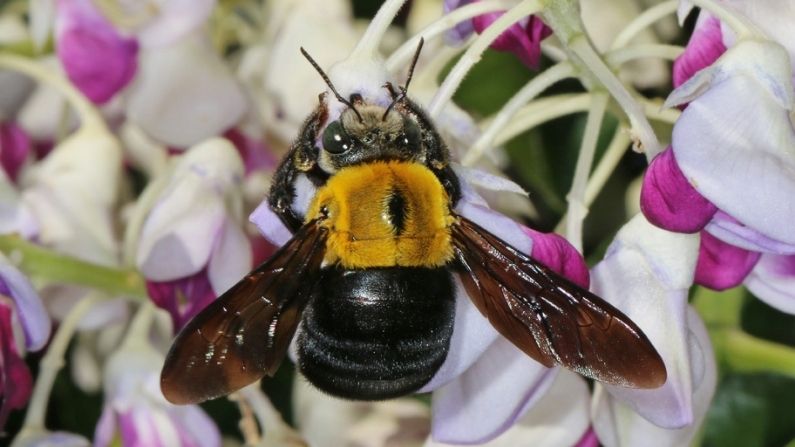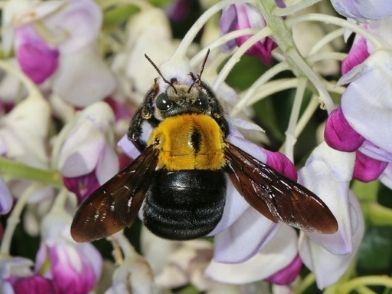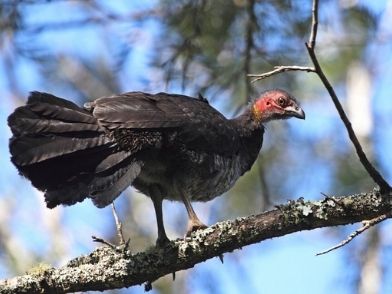Great
carpenter bee
© Jenny Thynne
Australia has more than 1600 species of native bees and 8 species of carpenter bees. Amongst the largest are the two groups of carpenter bees: Xylocopa (Koptortosoma) and Xylocopa (Lestis). Species in the subgenus Lestis are metallic green in colour, while those in the subgenus Koptortosoma are coloured quite differently. While most Australian carpenter bees are not threatened or endangered, they are of interest due to their spectacular appearance as well as their role as pollinators. Along with a few other groups of bees, they possess the ability to ‘buzz pollinate’.
Quick facts
Great carpenter bee
SCIENTIFIC NAME:
Xylocopa (Koptortosoma) aruana and Xylocopa (Koptortosoma) lieftincki
FAMILY:
Apidae
QLD CONSERVATION STATUS: (X.(K.) aruana and X.(K.) lieftincki)
Least Concern
NATIONAL CONSERVATION STATUS: (X.(K.) aruana and X.(K.) lieftincki)
Least Concern
Did you know?
Carpenter bees are named after their ability to carve nest burrows in timber or pithy stems using their strong ‘mandibles’ or jaws. In 1802, French entomologist Pierre André Latreille first described the genus whose name is derived from Ancient Greek and translates to ‘wood-cutter’.
Distribution
Description
Bees in the Koptortosoma subgenus
Females — The females have a glossy black abdomen, and their thorax is covered with bright yellow fur except for a small black oval at its centre. They can grow up to 23 mm in body length. As the gatherers of pollen for their young, the females are more often seen than the males. They make a loud buzzing sound when visiting flowers, and on occasion, have been mistaken for the introduced bumblebee (Bombus terrestris) which grows to a similar size. The latter, however, is currently confined to Tasmania where it was unintentionally introduced in the 1990s.
Males — The males are very different from the females in appearance, with yellowy-brown or olive fur covering most of their bodies. They can grow up to 26mm in length and do not sting.
Females and males both have smoky-coloured wings.
Distinction between the two species
It wasn’t until 1997 that X.(K.) lieftincki was recognised as a separate species from X.(K.) aruana thanks to research by Dr Remko Leys of the South Australian Museum. The distinction was discovered by microscopic comparison of various characteristics of the males, as the females appear to be virtually identical.

Habitat
Carpenter bee nests are found in soft, dry pithy stems or decayed wood (including old timbers in backyards). Known nesting trees and shrubs include:
- Casuarinas
- Ficus species
- Lophostemon grandiflorus
- Leptospermum species
- Terminalia catana
- Annona muricata (soursop tree)
- dead branches on mango
- Frangipani and jacaranda trees
- dead Eucalyptus robusta saplings
- Banksias
- dead flower stalks of grass trees (Xanthorrhoea species).
Breeding
Female great carpenter bees are attracted to the males when they detect the strong scent of a ‘pheromone’ or chemical perfume released by the males. The males establish individual territories, usually high in the tree canopy, which is also why they are seldom seen.
The females burrow out the nests, some of which may consist of a number of tunnels. They lay eggs on individual mounds of honey and pollen which are sealed with chewed wood particles, thus forming the brood cells. Females of subsequent generations have been known to occupy the same nest, and adult female carpenter bees may even feed their adult daughters. For this reason, carpenter bees are sometimes referred to as ‘para-social’, unlike the vast majority of Australia’s native bees which lead a solitary existence.
Food and food plants
Some plants store their pollen inside their saclike anthers which are usually tubular in shape with a small opening or pore at the top. A specific technique is required of insects wishing to collect this pollen. Some of our Australian native bees, including carpenter bees, use this technique known as ‘buzz pollination’ or ‘sonication’. The majority of native bees and the introduced honey bee (Apis mellifera) are not capable of performing the technique.
The female carpenter bee lands on the flower, curls herself around the anthers, and vigorously vibrates her flight muscles while buzzing loudly. The frequency of the ‘buzz pollination’ wing action is different from that used for flying, and the sound made by each of the two can be easily distinguished. The rapid movements loosen the pollen which flows out through holes in the anthers in a fine spray and onto the bee’s body.
Plants that hide their pollen in this way include native wildflowers such as Senna, Hibbertia and Dianella species, and commercial food crops such as tomatoes, capsicum, eggplants, chilli peppers, kiwifruit, blueberries and cranberries. Research is being conducted into the use of carpenter bees for passionfruit pollination.
Other known food plants include:
- Australian natives: Callerya megasperma (native wisteria), Eucalyptus species, Jagera pseudorhus (foambark), Canavalia rosae, Cassia species.
- Exotics: Grewia occidentalis (crossberry or lavender starflower), Tipuana species (a declared weed), Albizia species, Anacardium occidentale (cashew tree), Cajanus cajan (pigeon pea), Cassia fistula, Clitorea ternatea, Crotalaria, Hyptis, jasmines, laburnams, wisterias, Caesalpinia ferrea (leopard tree), Solanum species.
Other Australian native ‘buzz pollination’ experts are teddy bear bees (Amegilla bombiformis) and blue banded bees (Amegilla species).
More information
Publications & papers
- Leys, R. (2000), A revision of the Australian carpenter bees, genus Xylocopa Latreille, subgenera Koptortosoma Gribodo and Lestis Lepeletier & Serville (Hymenoptera : Apidae), Invertebrate Taxonomy; 14 (1) 115 – 136.
- Wildlife Australia Magazine – Summer 2019 edition
- Australian Native Bee Research Centre
- Aussie bees abuzz – ABC online>
- Magnetic Island wildlife




